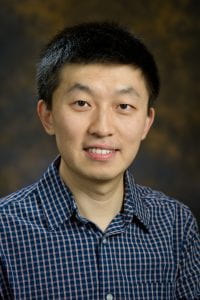Mapping the virus at the atomic level
Assistant Professor Yuan He has always been interested in life at the atomic level.
“I’ve always felt that we know so little about our surroundings,” He says. “What does life mean, on a very physical level? I’m fascinated by that.”
He pursued that fascination while earning his PhD in biochemistry and biophysics at Northwestern in 2008. As a postdoctoral researcher at the Lawrence Berkeley National Laboratory, He continued to refine his expertise in a technique called cryo-electronic microscopy. “Cryo-EM” allows researchers to visualize, at a very precise level, the molecular structure of the elements of life — just what He had always wanted to do.
He returned to Northwestern in 2015 as the Department of Molecular Bioscience’s cryo-EM specialist in structural biology — the study of the molecular dynamics of proteins, nucleic acids and uncrystalizable biological macromolecules. He gravitated toward the study of polymerase, an enzyme that synthesizes long chains of nucleic acids.
It was a fortuitous decision, as polymerase plays a key role in the evolution of viruses that cause diseases like mumps, measles and influenza — and COVID-19.
“A virus is actually a parasite,” He explains. “It can’t live without host cells. But viruses made a very clever and bold move as they evolved: they simplified the components that they need to become a parasite. So a virus’s genome is much, much smaller than that of other organisms on the planet.
“And one of the essential components that they have kept through this evolution is the enzyme polymerase, which assembles RNA molecules.”
To unlock the mysteries of this vital enzyme, He uses cryo-EM to peer directly into molecules to determine their three-dimensional shape. In February 2020, just as the pandemic was gaining steam around the globe, He and Robert Lamb, the Kenneth F. Burgess Professor of Molecular Biosciences, announced that they had, for the first time, determined the 3D atomic structure of a key complex in the virus family that includes coronavirus.
By getting a “very precise picture” of this particular enzyme, He says, researchers will eventually be able to devise therapies and drugs to shut down a virus’s ability to replicate itself. Such work has shown prior success with coronaviruses similar to the one that causes COVID-19, lending hope to researchers battling the current pandemic.
“People are interested in using the tools of cryo-EM to compare the strategies different viral branches use to do slightly different jobs,” He said. “You can almost construct an evolutionary tree of all these different viruses, because they all likely came from the same ancestor. So our research will not only allow us to fix one problem, but learn about other branches as well. And by comparing them, you can find potential weaknesses common to a lot of viruses.”
The work has the potential not only to alleviate the COVID-19 crisis, but to revolutionize other areas of healthcare as well.
“Viruses are important tools,” He notes. “Many viruses have no symptoms and cause no harm, so we can actually use them for drug delivery. So the more we learn about them, the more we can use them for things like gene therapy and a lot of other applications.”
